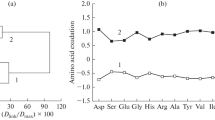Summary
Some polyphenolic compounds have been identified in root exudates of two species of legumes (both cultivated in sterile conditions): for lentil, three desoxy-5 flavones (4′,7-dihydroxy, 3′,4′,7-trihydroxy and 4′,7-dihydroxy, 3′-methoxyflavones) and for soybean: two isoflavonoids, coumestrol and daidzein (or 4′,7-dihydroxyisoflavone). Identified compounds are polyphenolic aglycones whereas roots contain the corresponding glycosides, showing that a hydrolysis takes place at the time of exudation. Compounds are observed in plantlet exudates as soon as the first day after planting. Their daily quantitative variations parallel those of total phenolic compounds. Exudated coumestrol and 4′,7-dihydroxyflavone amounts are estimated at about 20% of root content in these molecules.
Similar content being viewed by others
References
d'Arcy Lameta A 1982 Etude des exsudats racinaires de soja et de lentille. I Cinétique d'exsudation des composés phénoliques, des amino acides et des sucres au cours des premiers jours de la vie des plantules. Plant and Soil 68, 399–403.
d'Arcy Lameta A 1984 Recherches sur quelques flavonoïdes et isoflavonoïdes des exsudats racinaires chez deux Légumineuses (lentille et soja) en relation avec lesRhizobium spp. et d'autres microorganismes du sol. Thèse de Doctorat ès Sciences, Université Paris VI, 216 p.
Audier H 1966 Etude des composés flavoniques par spectrométrie de masse. Bull. Soc. Chim. Fr. 9, 2892–2898.
Barz W 1969 Metabolism of aromatic plant constituents. I On the turnover of isoflavones and coumestans inCicer arietinum L. andPhaseolus aureus Roxb. Z. Naturforsch. 24b, 234–239.
Barz W 1977 Degradation of polyphenols in plants and plant cell suspension cultures. Physiol. Veg. 15, 261–277.
Bhuvaneswari T V, Turgeon B G and Bauer W D 1980 Early events in the infection of soybean (Glycine max L. Merr.) byRhizobium japonicum. I Localization of infectible root cells. Plant Physiol. 66, 1027–1031.
Bickoff E M, Booth A N, Lyman R L and others 1957 Coumestrol, a new estrogen isolated from forage crops. Science 126, 969–970.
Bickoff E M, Livingston A L and Witt S C 1965 Identification of 7,4′-dihydroxyflavone in forages. Phytochem. 4, 523–524.
Bickoff E M, Spencer R R, Witt S C and Knuckles B E 1969 Studies on the chemical and biological properties of coumestrol and related compounds. Tech. Bull. no. 1408, USDA 95 p.
Burden R S, Rogers P M and Wain R L 1974 Investigations on fungicides. XVI Natural resistance of plant roots to fungal pathogens. Ann. Appl. Biol. 78, 59–63.
Chaboud A 1984 Isolation, purification and chemical composition of maize root cap slime. Plant and Soil 73, 395–402.
Chang C F, Suzuki A, Kumai S and Tamura S 1969 Chemical studies on ‘clover sickness’. II Biological functions of isoflavonoids and their related compounds. Agr. Biol. Chem. 33, 398–408.
Collet G F 1975 Exsudations racinaires d'enzymes. Soc. Bot. Fr., Coll. Rhizosphère, 61–75.
Dazzo F B, Truchet G L, Sherwood J E, Hrabak E M and Gardial A E 1982 Alteration of the trifoliin A-binding capsule ofRhizobium trifolii 0403 by enzymes released from clover roots. Appl. Environ. Microbiol. 44, 478–490.
Dyer D and Brown D A 1983 Relationship of fluorescent intensity to ion uptake and elongation of soybean roots. Plant and Soil 72, 127–134.
Ingham J L 1982 Phytoalexins from the Leguminosae.In Phytoalexins. Eds A Bailey and J W Mansfield. Blackie, 21–80.
Mabry T J, Markham K R and Thomas M B 1970 The systematic identification of flavonoids. Springer Verlag, 354 p.
Morandi D, Bailey J A and Gianinazzi-Pearson V 1984 Isoflavonoid accumulation in soybean roots infected with vesicular-arbuscular mycorrhizal fungi. Physiol. Plant. Pathol. 24, 357–364.
Olah A F and Sherwood R T 1971 Flavones, isoflavones and coumestants in alfalfa infected byAschophyta imperfecta. Phytopathology 61, 65–69.
Přikryl Z and Vančura V 1980 Root exudates of plants. VI Wheat root exudation as dependent on growth, concentration gradient of exudates and the presence of bacteria. Plant and Soil 57, 69–83.
Shapovalov A A 1972 Effect of increased temperature in kinetics of fluorescent component exudation from soybean and oat roots. Soviet Plant Physiol. 18, 135–138.
Tamura S, Chang C F, Suzuki A and Kumai S 1969 Chemical studies on ‘clover sickness’. I Isolation and structural elucidation of two new isoflavonoids in red clover. Agr. Biol. Chem. 33, 391–397.
Wong E and Francis C M 1969 Flavonoids in genotypes ofTrifolium subterraneum. I. The normal flavonoid pattern in the Geraldton variety. Phytochem. 7, 2123–2129.
Author information
Authors and Affiliations
Rights and permissions
About this article
Cite this article
d'Arcy-Lameta, A. Study of soybean and lentil root exudates. Plant Soil 92, 113–123 (1986). https://doi.org/10.1007/BF02372272
Received:
Revised:
Issue Date:
DOI: https://doi.org/10.1007/BF02372272




